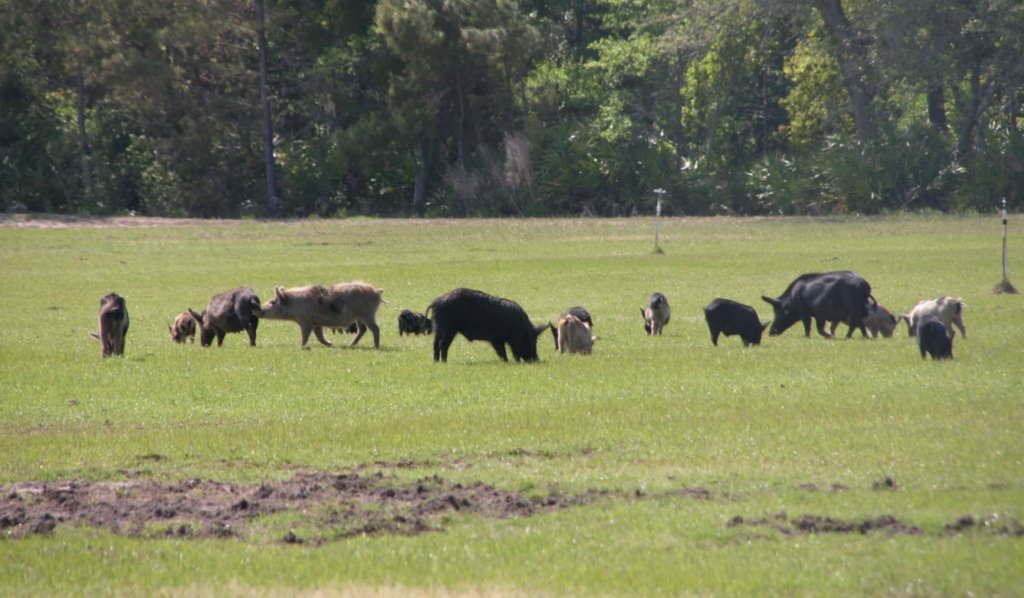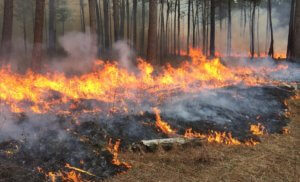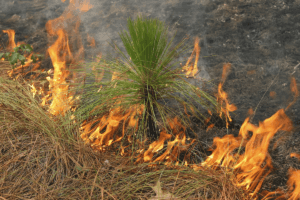In Southeastern North America, free-range prescribed fire loses its effectiveness when free-range feral swine tear up the fuels. Lessons from the nexus of invasive species and fire management.

by Johnny Stowe
Feral swine are causing yet another problem for the natural resources of Southeastern North America and the people who manage, enjoy and depend on them — this time by interfering with prescribed burning.
Feral pigs (Sus scrofa) are invasive, non-native vermin that devastate the region’s natural and agricultural resources. Native to Eurasia and North Africa, they don’t belong in the New World. They were brought to the Americas by explorers and settlers in the early sixteenth century who let them range free, hunting or rounding them up now-and-then to eat, or for market. For centuries these pigs, mixing with those escaped or released from hunting preserves or farms, were mainly confined to large river-bottoms and rugged mountains, with rural folks in subsistence economies keeping populations at bay.
Yet in recent decades, changes in land uses, translocation by hunters and other socioeconomic factors have led to wild pig population explosions across the North American continent. Not only are existing populations growing, but they are spreading to other states. In 1982 wild pigs were found in scattered populations in 18 states, but now they have been documented in at least 35 states as well as at least six Canadian provinces. In the USA alone, there are about 6 million wild hogs causing at least $1.5 billion in damages per year.
Unchecked wild hog populations normally exhibit exponential growth – the classic “J-shaped” growth curve. No other large mammal on the continent has such reproductive potential. One of the first things I learned as a 4-H Club lad showing livestock in the county fair was the short gestation period of hogs – about three months, three weeks and three days. That’s bad enough, but they can also breed at six months and have six or more young per litter, with many, often most, surviving. Couple this with the fact that they did not evolve in North America and have no natural predators, competitors or population-limiting diseases or parasites – and the result is destructive, ecological irruption.
Wild pigs are one of the world’s most destructive invasive species, being included in the IUCN’s top 100 “World’s Worst” invaders. In Australia they arrived on the First Fleet in 1778. Now feral swine there number some 24 million, and are considered among Queensland’s most damaging pest animals.
Wherever free-ranging pigs are found in North America they invariably harm natural ecosystems. They consume and trample rare plants and tree seedlings; raid corn, peanuts and other crops; and every acorn or other wild fruit eaten by a hog is one less that is available for white-tailed deer, wild turkey and other native wildlife species. Feral pigs also prey on ground-nesting birds and on amphibians and reptiles. They are a major threat to the nests of imperiled sea turtles, quickly learning how to find and root up the eggs. It’s likely easier to name the things that they do not eat than it is to list the things they do. They also disturb archaeological sites and are hazards for automobiles and even aircraft.
Colliding with a wild pig is probably not high on the hazards of wildland fire aviation. But it could happen, though, and not just in the deep bush. In 1998 at Jacksonville (Florida) International Airport, a USDOD Air National Guard F-16 fighter was destroyed when it struck a pair of wild pigs. Commander Don Garrett, who was piloting the jet, was able to safely eject, but the $16 million plane was destroyed. Colonel Garrett had flown jets for 24 years, including sorties over Vietnam, but this was the first time he ever had to bail out of an aircraft. https://www.latimes.com/archives/la-xpm-1988-06-10-mn-5151-story.html.
The wallowing of swine contaminates water sources and serves as potential vectors for diseases that are harmful, even fatal, to people. Wild pigs carry certain disease organisms that generally cause them little harm, but these same microbes can have severe public health consequences and cripple modern hog farming operations. They are known to carry at least 30 viral and bacterial diseases that can be transmitted to humans, pets, livestock and other wildlife. Now and then, in places where they aren’t hunted, they get cheeky and attack people, livestock and pets.
Impact on Prescribed Fire
Well, all that is bad enough, but it is really getting personal with me now, because they are interfering with my prescribed burning! The main problem is fuel disruption. Feral hogs are roamers, and even one small sounder can impact a large area. Unless they have a concentrated food source such as in an agricultural situation, they pass through an area wallowing and rooting and then moving on, in large part because they have gleaned the area clean. It might be weeks or many months later, but they will eventually come back through.
It doesn’t take a seasoned hunter to tell when wild pigs are around. Everywhere they go they leave swaths and scattered patches of bare ground, and this breaks up the continuity of the fine fuels I depend on to carry my fires. I do all of my burning by hand and on-foot, dragging my drip torch in strips, or else lighting “spots” – relying on artfully-lit fires to carry over the rest of the site. But when these fires reach areas where hogs have trampled, rooted and wallowed in the leaves, grasses and other fine fuels that carry the fire, the fire goes out. And in each of those places where the fire goes out, undesirable woody species, both native and exotic, invade.
Given the climate of the Southeast, with long-growing seasons and abundant rainfall, it doesn’t take long for a frequent fire-dependent ecosystem to fall apart – once effective fire is taken out of the equation, species composition and overall vegetative structure of the land rapidly change as ecological feedbacks are distorted — and restoration becomes difficult, expensive and in some cases, impractical. With limited resources, I sometimes end up having to reallocate my energy to other areas. Or switching to herbicide or mechanical applications to manage vegetation. Which is a lot more expensive – and a lot less fun! Plus, fire has certain benefits that chemical and mechanical operations cannot provide, such as rapid nutrient recycling, stimulation of plant reproduction and removal of fuels.
Managing Invasive Hogs
Many land managers shoot every hog they can in the course of their work, and year-round we actively hunt them over bait and with dogs, and we trap them. But even in places where we intensively do these things, these invasive swine persist. Feral swine populations are extremely difficult to extirpate, and in situations where this can be done, they will re-infest an area if there are nearby source populations. One positive aspect of this responsibility is that wild pigs are quite tasty, although mature boars tend to be rank and pretty much not fitten to eat.
Many, probably most, introduced species are not invasive, requiring nurturing to persist and thrive, and much of the world’s food comes from plants growing far from their native land, but we have been far too careless with the way we move species around. Now and then, one comes along and reminds us of our folly. The fungal blight that wiped out the American chestnut is one of the worst cultural, ecological and economic tragedies of North America. The Cherokee and other First Nations people once burned the woods in fall to expose the chestnuts and make gathering them easier, a practice later followed by European settlers.
The global threat to native biodiversity by invasive species is second only to human-caused habitat destruction. Tim Flannery and others have described the problems with invasive, exotic species in Australia, and there are not many, if any, places on the face of the earth where introduced plants and animals and microbes and fungi are not creating havoc. Some of the most hazardous fuels in the wild, rural and urban environments, species such as cogongrass, are non-natives.
But all is not woe. Increasingly in papers and presentations from IAWF and beyond, we are learning of ways to deal with invasive plant species in a fire context – how to limit their spread (e.g. by cleaning equipment before transporting it from infested areas), how to control them (herbicides are now much more selective and biodegradable), how to deal with them as fuels – overall, how to reduce their threat to public safety, and to lessen their ecological, economic and cultural impacts. Addressing these issues may well turn out to be one of the major wildland fire research and management challenges of the future.
To amplify but not exaggerate an old adage – when it comes to some introduced species, an ounce of prevention is worth countless tons of quasi-cure! So, as we figure out how to deal with “what we got” – let’s be careful what we move around!
For more information
Barrios-Garcia, M. N, and Ballari, S. A. 2012. Impact of wild boar (Sus scrofa) in its introduced and native range: a review. Biol Invasions. 14: 2283–2300.
Mayer, J.J. and I.L. Brisbin. 2008. Wild Pigs in the United States: Their History, Comparative Morphology and Current Status. The University of Georgia Press. 313 pp.
Smyser et al. 2020. Mixed Ancestry from Wild and Domestic Lineages Contribute to the Rapid Expansion of Invasive Feral Swine. Molecular Ecology 29(6):1103- 1119. https://nwrc.contentdm.oclc.org/digital/collection/ NWRCPubs1/id/66652/rec/6.
Wild Pigs in Canada. University of Saskatchewan. http://wildpigscanada.ca/


